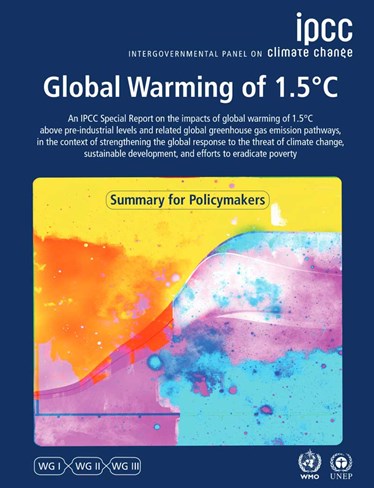
 Climate change has been spoken about in the future tense for years: from “severe droughts will become common,” to “coral reefs will be hugely impacted,” to “wildfires will be very destructive.” Now, a new report illustrates how very soon that future will happen; indeed, in some cases it already is happening. Instead of the 2.0 degrees Celsius of global average temperature rise that scientists warned would trigger extreme climate change, the science compiled in this new report reveals that we will already be suffering with 1.5 degrees of temperature rise, and that even 2 degrees would be much worse.
Climate change has been spoken about in the future tense for years: from “severe droughts will become common,” to “coral reefs will be hugely impacted,” to “wildfires will be very destructive.” Now, a new report illustrates how very soon that future will happen; indeed, in some cases it already is happening. Instead of the 2.0 degrees Celsius of global average temperature rise that scientists warned would trigger extreme climate change, the science compiled in this new report reveals that we will already be suffering with 1.5 degrees of temperature rise, and that even 2 degrees would be much worse.
The report was issued by the Intergovernmental Panel on Climate Change (IPCC), a body assembled by the UN to assess and report on the state of the science on this global issue. Scientists from around the world work together to understand what the research is saying about many questions pertaining to climate change. Their carefully crafted, thick reports each come with a summary of the science for policy makers, to guide world leaders with the latest findings. The IPCC has written five general reports so far, and in 2016, countries assembled at the 2015 COP21 Paris Climate Talks commissioned a more specific report, focusing on the different consequences of 1.5 versus 2 degrees of warming, and if limiting warming to 1.5 degrees was actually still possible.
"One of the most important findings of this report is that limiting warming to 1.5°C is actually possible," says Anna Pirani, an ICTP consultant scientist and the head of the IPCC’s Working Group One Technical Support Unit. Before the report, it was not clear if there were still decision crossroads for limiting warming, or if the path had been decided on by lack of action. Jim Skea, the Co-Chair of Working Group Three said: "Limiting warming to 1.5°C is possible within the laws of chemistry and physics, but doing so would require unprecedented changes... it is up to countries to decide.”
Those "required unprecedented changes" include reducing carbon dioxide emissions by 45 percent down from 2010 global levels by 2030, only twelve years away. Emissions would have to reach net zero by 2050. This would go hand in hand with deep cuts in methane emissions and other non-CO2 emissions. Heavy carbon taxes would be needed, coal burning would need to be almost completely eliminated, and renewable energy sources would have to become much more widely and heavily used. Not only would economic, transport, land use, infrastructure, industry and energy systems need to drastically change to have a chance of limiting global warming to 1.5°C, existing technologies that can scrub carbon out of the air would need to be widely deployed. In order to keep warming to only 1.5°C, it would not be enough to stop emitting greenhouse gases: removing previous emissions would also be key.
The report, Global Warming of 1.5 °C, also answers a long-pressing question about development. “Another highlight of the report is that limiting global warming to 1.5°C is not incompatible with achieving sustainable development and poverty eradication,” says Pirani. In other words, fighting climate change does not mean that other sustainable development goals have to be abandoned; ethical and fair transitions away from fossil fuels can support economic development and the elimination of poverty.
“We still have a choice,” Pirani says. “Every part of a degree that the planet warms matters, with increasing warming bringing increasing climate impacts and risks for ecosystems, food and water security, health, livelihoods, and economic growth.” The 2015 Paris Climate Talks had initially focused on plans to limit warming to 2 degrees, but many nations that had already started to see drastic effects from climate change wanted a more ambitious target, and asked the IPCC to investigate if limiting warming to 1.5 degrees was possible. That began a process where 90 scientists from 45 countries volunteered their time to analyze more than 6,000 studies and compile the results into the new report.
The process of assembling the report was a complicated one, that Pirani was closely involved with, leading the coordination of authors and drafting. The IPCC has been writing reports on the state of the science on climate change since 1988, with an established system of working groups, authorship and review. For this report, there was coordination across the scientific leadership. “This is the first time a full report has been done across the working groups,” says Pirani, “There was an inspiring collaborative environment, and it was really stimulating to be exposed to the full breadth of climate change science.”
The 1.5 report has chapters organized around cross-cutting topics, Pirani says, with chapters on mitigation pathways, sustainable development goals, and impacts. "Authors from different disciplines connected and collaborated in new ways. That sets us up well for the main working group reports of the sixth assessment report (AR6)."
The request for this report also spurred a lot of new research on the different scenarios that 1.5 versus 2 degrees would bring. Scientists started looking into pressing questions, such as: What is the state of the science on climate budgets and limiting warming? What would limiting warming to 1.5°C mean for energy supplies, transportation systems, economies, and development? “Between 1.5 and 2 degrees of warming there are differences in climate impacts and risks,” says Pirani, for example, sea level, heavy precipitation, droughts, and heat extremes, on the habitability of the planet for humans and other species.
The IPCC reports must be policy-relevant, not to be policy-prescriptive, Pirani says. The pathways to limiting warming to 1.5 degrees all require a careful mix of policies to adapt, mitigate and develop together with cooperation, governance, innovation and investment. Limiting global warming to 1.5°C is not impossible, but political will to accelerate transitions is key.
As Andy Reisinger, vice-chair of Working Group III wrote, translating the report into haiku:
"We wrote this report
at your request, and with care.
Will you listen please?"
The report has been launched this year's UN Framework Convention on Climate Change Conference taking place in Poland, where governments will be negotiating the rule book of the Paris Agreement on tackling climate change. The IPCC had a joint pavillion with the World Meteorological Organisation where they presented the special report. To access the report visit the IPCC website or follow news on Twitter @IPCC_CH.
----- Kelsey Calhoun
















